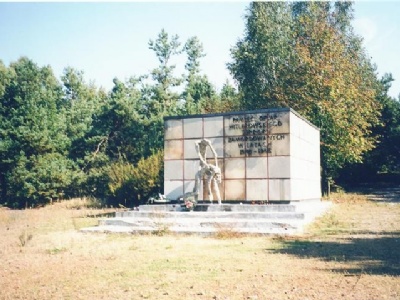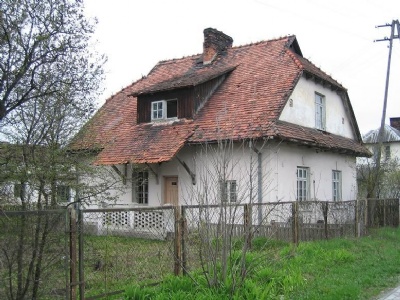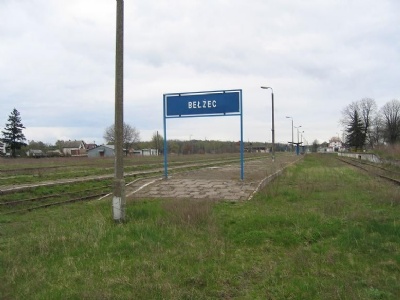Belzec
In southeast Poland the Nazis built their first extermination camp with stationary gas chambers. The decision to set up an extermination camp in the small village of Belzec in General Government dates back to autumn 1941, when the proposal to deport the Jews further east was rejected by Alfred Rosenberg’s East Ministry. The large concentration of Jews in the Government then created problems for the local Nazis. In Lublin district of the General Government, in autumn 1941, the district’s supreme SS and police chief, Odilo Globocnik, proposed a solution to SS chief, Heinrich Himmler, to build a extermination camp in the small town of Belzec. In this camp of death, According to Globocnik, not only the Jews from Lublin district could be killed, but also Jews from Galicia district could be killed in stationary gas chambers. Himmler approved this plan and in November 1941 began construction of the extermination camp in Belzec.
By 1940, the Nazis had established a labor camp with the same name. The prisoners who were in that camp began to build the extermination camp itself. The fact that there was already an existing camp on the site also served as a camouflage and the Nazi name of the camp remained Arbeitslager Belzec. It was for three reasons that the camp was placed at the small town of Belzec. Firstly (1) Belzec was at a large railway junction which made it easy for the Nazis to transport Jews to Belzec. Secondly (2) it was on the border between the districts of Lublin and Galicia, which made it possible to transport Jews from both districts to the camp. The camp was set up primarily to murder Jews from the ghettos of Lublin, Lviv and Krakow. Thirdly (3) and lastly, there were already large anti-tank pits excavated the year before for military purposes. These no longer fulfilled any function and could therefore be used as mass graves.
The Inspector of the euthanasia centers in Germany, Christian Wirth, became Belzec’s first commandant. Wirth was a proponent of carbon monoxide (the gas used in the euthanasia program), but for confidentiality and practical reasons, it was not possible to use gas on tube in Belzec, therefore it was necessary to find another solution for the murders to the extent planned in Belzec. The solution was an engine from either a truck, tractor or a tank, we don’t exactly know. The Engine was installed in an adjacent shed and the exhausts (gasoline or diesel) was introduced via pipelines into the gas chambers (camouflaged as shower rooms). The Victims died of carbon monoxide poisoning.
In mid-March 1942, the first transportation of Jews to Belzec arrived from Lublin and Lviv. Belzec became the first of three extermination camps in what has been called operation Reinhardt, which meant the Nazis’ plan to murder all Jews within the government. But when Belzec began construction, the other two camps, Sobibor and Treblinka, had not begun. In June 1942 Wirth was replaced as commander by another veteran from the T-4 program, Gottlieb Hering. Wirth’s new role was to be inspector of all three camps in operation Reinhardt.
As the first stationary extermination camp, there were several technical problems in the murder process. The mass graves were also found to be too shallow, causing the corpses to surface the ground when they swelled up. The three original gas chambers were also not sufficient because the transport from Krakow and Lviv arrived at a faster and larger rate than the gas chambers could handle. The three old gas chambers measured three times three meters while the new ones built in June 1942 measured six times four meters. With its new gas chambers, Belzec more than doubled its capacity to kill people. The organization in Belzec was the same as in the two other Operation Reinhardt camps. About 30 SS officers and about 100 Ukrainian guards and a few 100 prisoners who worked with the murder process. Meaning they recieved new arrivals until they were buried in the mass graves. The only real difference between these three camps was that Belzec was smaller than the other two. Measuring 300 by 300 meters while the others measured 600 by 400 meters. In 1942, the last transport of Jews arrived in Belzec.
If Chelmno was the first extermination camp established by the Nazis, Belzec was the first large-scale extermination camp to be established. It was in Belzec the Nazis experimented with murder and the experiences made in Belzec were used when other extermination camps were built. The decision to liquidate Belzec was prompted partly by the fact that the camp was an experimental camp and that it could not expand because it was too close to the community. The remaining Jews in the districts of Lublin an Galicia who could not be killed in Belzec were sent to the extermination camp in Sobibor. Soon, even the newer and more modern facilities planned at Auschwitz would be ready to kill the remaining Jews in the districts. The Nazis demolished the camp and removed all technical equipment.
It is difficult to determine how many Jews were killed in Belzec, but a figure most often mentioned in this context is 600,000. In 2001, researchers Stephen Tyas and Peter Witte found a document from Operation Reinhardt’s deputy Hermann Höfle, who wrote that until December 31, 1942, 434,508 Jews were murdered in Belzec. Whether it was 400,000 or 700,000 killed in Belzec is less important, what is important is that Belzec was an anthropological treatment plant where the Nazis tried to realize their racial ideological dreams, to annihiliate European Jewry.
Current status: Demolished with museum (2000).
Address: Ul. Ofiar obozu 4, 22-670 Belzec.
Get there: Car.
Follow up in books: Arad, Yitzhak: Belzec, Sobibor, Treblinka – The Operation Reinhardt death camps (1987).




Of the extermination camp itself nothing remains, but outside there are buildings left, for instance the commandant’s villa and the locomotive garage where the property of the murdered was stored before it was sent away. For a long time there was an opinion that only two prisoners survived Belzec and that there were few who knew about the camp, but this is not true. Several prisoners who were forced to work in the camp fled in connection with transports back and forth the camp and could spread information about what was going on in the camp. In addition, the camp was largely in the middle of a community, which made it impossible for the Nazis to hide its purpose. Belzec may for post-war history be the least known of the three Reinhardt camps but during its existence it was no big secret.
Before the new memorial and museum was opened in 2004, the old memorial (there was no museum at the time) was somewhat worn and decayed. But at least there was an authenticity where you could wander around the former camp area among twigs and sand. The new memorial, on the other hand, is a gigantic complex with no authenticity. I really hope that the other two operation Reinhardt camps does not suffer the same faith as Belzec.